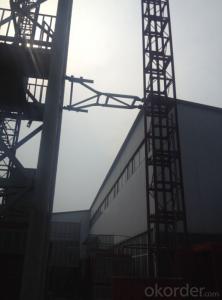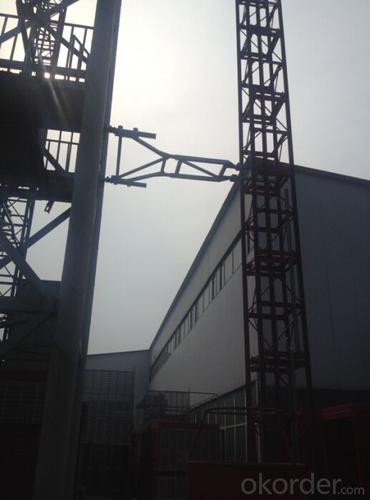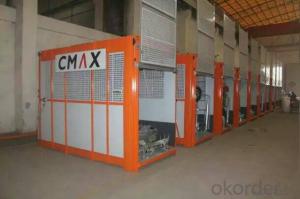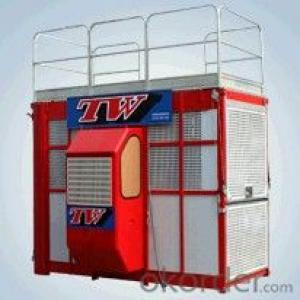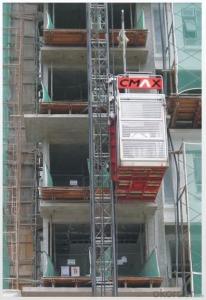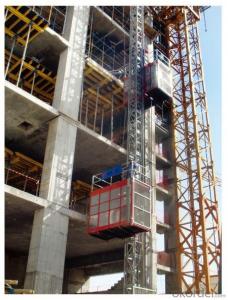Conversion Construction Hoist / Construction Tower Hoist / Building Hoist
- Loading Port:
- China main port
- Payment Terms:
- TT OR LC
- Min Order Qty:
- 1 set
- Supply Capability:
- 1000 set/month
OKorder Service Pledge
OKorder Financial Service
You Might Also Like
Specification
SC200/200 3*2*11kw building electric hoist
Descriptions of our building hoist:
SC100 construction hoist is a new generation product designed by construction mechanization research, Chinese Academy of Architecture. It is of high technology and of high safety, convenient to maintain, is an ideal Vertical transport tool for modern building .
Main Features of Building Material Hoist
1. the recommended cage dimension(LXWXH):2.0X1.0X2.5, 2.5X1.0X2.5, 2.5X1.3X2.5, 3.0X1.5X2.5, 3.2X1.5X2.5, 3.8X1.5X2.5, 4.0X1.5X2.5, 4.2X1.5X2.5 etc, we can also manufacture cages of other size according to the user.
2. The cage and the door material can be aluminum molded board, punched-plate, figured aluminum board or other type according to your requirements.
3. The mast and the tie-in surface can adopt paint-spray, or hot galvanizeing processing.
Advantage of our building hoist:
1. Our own systems of production engineering.
2. Production design from the concept to the engineering details.
3. Technical experts with great experience in the sector.
4. Continuous development of new solutions and products adapted to the requirements of our clients.
5. Methodology and project procedure administration in compliance with current guidelines.
6. Extensive worldwide commercial network
Specification of our building hoist:
Characteristic | Model | Rated Loading | Lifting Speed | Motor Power |
Double cabin | SC200/200 | 2×2000kg | 33m/min | 2×(3×11kw) |
SC150/150 | 2×1500kg | 33m/min | 2×(2×15kw) | |
SC100/100 | 2×1000kg | 33m/min | 2×(2×11kw) | |
Single cabin | SC200 | 2000kg | 33m/min | 3×11kw |
SC150 | 1500kg | 33m/min | 2×15kw | |
SC100 | 1000kg | 33m/min | 2×11kw |
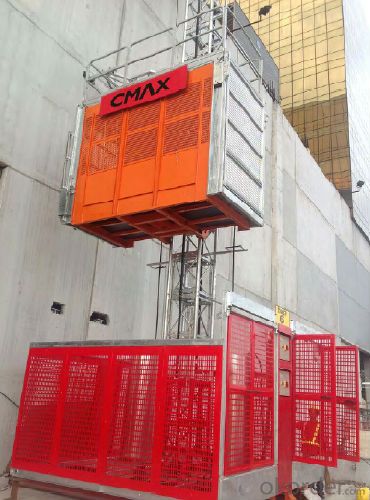
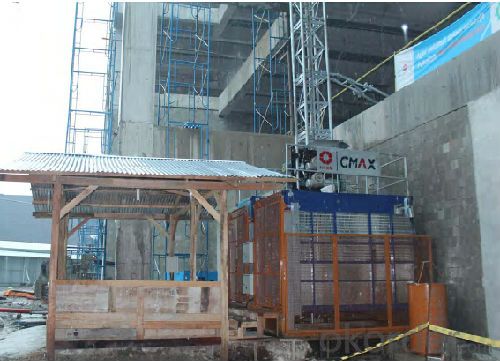


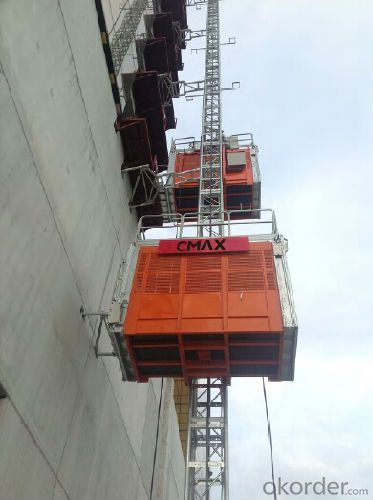
Production line
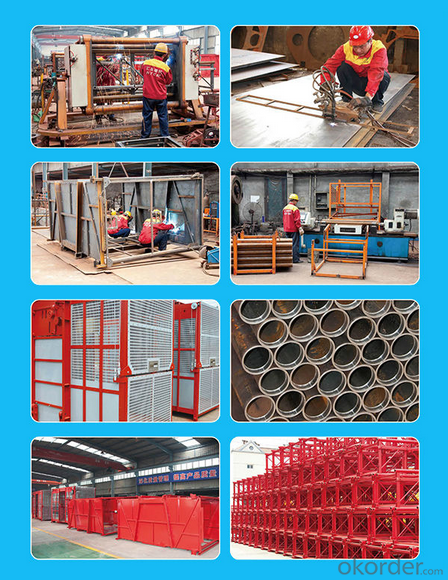
FAQ
1. why chose us?
China National Building Materials (Group) Corporation (CNBM), established in 1984,now is one of the largest state-owned group corporation in China, dealing with building materials & industrial equipment. Up to year 2010, CNBM Group's total asset is 20 billion USD and total staff is more than 100,000.CNBM International Corporation, specializes in designing & manufacturing of various
kinds of construction machinery, including tower crane, building hoist, etc. All the equipment produced by CNBM are compliant with the National level quality standard, and wins great reputation for their endurable performance in worldwide markets.
2.How about the shipment?
You can put 2 sets of of wheel loaders in one 40HQ container. The spare parts are packed with boxes.
The delivery time is 20 days.
3. What about your service?
We have our factory, we can meet customers needs as soon as possible.
We have first rate professional technology and provide good after-sales service.
4.After Sales Service
We offer the Preventative Maintenance and After Sales Service. For we strongly feels about the importance of supporting our customers and the product solutions we provide. Consequently we offer comprehensive maintenance options to prevent equipment issues before they become problems. Also we offer one year guarantee period.
- Q: This question seeks to understand the distinctions among various types of building hoists, which are essential in construction for lifting materials.
- <p>Building hoists, also known as construction hoists, are crucial for transporting materials and personnel in construction projects. The main types include: 1) Goods Hoists, designed for lifting materials and equipment, often with a higher load capacity. 2) Personnel Hoists, specifically for workers, prioritize safety features. 3) Material Hoists, a combination of goods and personnel hoists, allowing both material transport and worker movement. 4) Electric Chain Hoists, powered by electricity, known for their efficiency and control. 5) Manual Chain Hoists, requiring manual operation, useful in areas with no power supply. 6) Electric Winch Hoists, offering high lifting speeds and capacities. Each type varies in capacity, speed, control mechanisms, and power source, impacting their suitability for specific construction needs.</p>
- Q: Can a building hoist experience technical issues or fail to operate properly?
- <p>Yes, a building hoist can malfunction. Like any mechanical system, hoists are subject to wear and tear, component failure, and can be affected by human error. Malfunctions may include mechanical breakdowns, electrical faults, or safety device failures. Regular maintenance, inspection, and adherence to safety protocols can reduce the risk of hoist malfunctions.</p>
- Q: Explain how a lifting platform, specifically a building hoist, operates.
- <p>A building hoist, also known as a construction hoist, is a temporary lifting platform used in construction to lift materials and personnel vertically within a building under construction. It operates by using a motor-driven pulley system that runs on guide rails or tracks. The hoist is attached to the building structure and as the building grows, the hoist is extended upwards. The platform is loaded with materials or workers, and the operator controls the ascent or descent through an electrical switch or remote control. Safety features include limit switches to prevent over-travel, safety catches to stop the platform in case of a cable failure, and interlocks to ensure the platform cannot be operated when the doors are open.</p>
- Q: What are the pros and cons of utilizing hydraulic fluid within the system of a building hoist?
- <p>The advantages of using hydraulic fluid in a building hoist include smooth and controlled lifting, which reduces the risk of accidents. It also offers a compact design due to the high power-to-weight ratio of hydraulic systems. Additionally, hydraulic systems are known for their durability and low maintenance requirements. However, there are disadvantages such as the potential for leaks, which can be hazardous and costly to repair. The systems can also be sensitive to temperature changes, which might affect performance. Lastly, hydraulic fluids can be environmentally harmful if not properly managed, posing disposal challenges.</p>
- Q: What are the primary roles or purposes that a building hoist serves in construction?
- <p>Building hoists, also known as construction hoists, serve several essential functions in construction projects. They are primarily used for the vertical transportation of workers, materials, and equipment within a building under construction. They increase efficiency by reducing the time and effort required to move materials and personnel, ensuring a faster construction process. Hoists also enhance safety by providing a controlled and secure means of vertical transportation, reducing the risk of accidents associated with manual material handling. Additionally, they contribute to the overall project timeline by allowing for simultaneous work on multiple floors, improving the coordination of construction activities.</p>
- Q: This question asks for a comparison between electric and electric-hydraulic building hoists, highlighting their distinct features and how they differ from each other.
- <p>Electric building hoists are powered solely by electric motors, which provide direct and precise control over the lifting and lowering of loads. They are quieter, require less maintenance, and are more energy-efficient compared to their hydraulic counterparts. On the other hand, electric-hydraulic building hoists combine the power of an electric motor with the force amplification capabilities of hydraulic systems. These hoists offer greater lifting capacity and can handle heavier loads but are generally more complex, requiring regular maintenance of hydraulic components. They are also louder and may consume more energy. The choice between the two often depends on the specific requirements of the lifting task, such as load capacity, precision, and environmental considerations.</p>
- Q: What precautions should be taken on construction sites when operating a building hoist?
- <p>Safety measures for using a building hoist in construction sites include regular inspections and maintenance to ensure the hoist is in good working condition. Operators must be trained and certified to use the hoist. Safety barriers or gates should be installed to prevent unauthorized access. Load limits must be strictly adhered to, and overloading is prohibited. Emergency stop buttons should be easily accessible. Workers should wear appropriate personal protective equipment (PPE). Regular safety briefings and training sessions should be conducted to keep workers informed about safe hoist operation procedures.</p>
- Q: What are the necessary steps and checks required to maintain a building hoist to ensure its safe and efficient operation?
- <p>Building hoists require regular maintenance to ensure safety and efficiency. This includes daily inspections of the hoist's mechanical and electrical components for any signs of wear or damage. Monthly, a thorough inspection should be conducted by a qualified technician, including checking the hoist's cables, brakes, and safety devices. Lubrication of moving parts and replacement of worn components are also crucial. Annually, a comprehensive inspection and certification by a professional is necessary to comply with safety regulations. Adherence to the manufacturer's guidelines is essential, and any malfunctions should be addressed immediately to prevent accidents.</p>
- Q: How does the construction elevator add up
- You can use a ready-made high-altitude operating platform and a high-altitude working platform
- Q: What are the fundamental parts that make up a building hoist?
- <p>The basic components of a building hoist include the hoist machine, mast or tower, guide rails, lifting cage, counterweight system, safety devices, electrical control system, and communication system. The hoist machine powers the lifting and lowering of the cage, while the mast provides structural support. Guide rails ensure the cage moves vertically, and the counterweight balances the cage's weight. Safety devices protect against accidents, and the electrical control system manages operations. The communication system allows for coordination between the hoist operator and other construction personnel.</p>
Send your message to us
Conversion Construction Hoist / Construction Tower Hoist / Building Hoist
- Loading Port:
- China main port
- Payment Terms:
- TT OR LC
- Min Order Qty:
- 1 set
- Supply Capability:
- 1000 set/month
OKorder Service Pledge
OKorder Financial Service
Similar products
Hot products
Hot Searches
Related keywords
